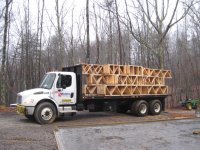Obed
Elite Member
Pops, yes that's the type of trusses we ordered. In fact they arrived today. Here they are on the delivery truck.Are your trusses built out of 2X4's turned flat ways? Those things are incredibly strong, plus they make life easier for the mechanical and electrical guys.
Pops
Obed

